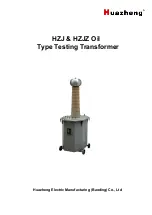
2
should not be exposed to ambient temperatures below
-40°C (-40°F) or above +70°C (+160°F). Special precau-
tion should be made to prevent exposure to corrosive
atmosphere, excessive vibration, shock or physical
damage. It is preferable that the NRF is not installed in
proximity to high voltage wires or other sources of high
electrical noise.
METAL WALLED TANKS
It is a common practice to use the metal tank wall as the
reference electrode. In such cases, it is required that the
probe housing makes a good electrical connection to
the tank wall. If there is any doubt about this connection
due to the use of PTFE thread tape, gaskets, paint, rust,
or any other reason, a separate grounding wire should
be installed between the probe and the tank housing. In
case the probe housing is non-metalic, or if the connec-
tion fitting is non-metalic, a grounding wire must be con-
nected from the tank to the G terminal on the transmitter.
This unit contains CMOS electronics which may
be damaged by static electricity. Electronics may
be accessed by removing the top cover of the
enclosure (head). Do not remove the transmitter
face plate (and touch the electronics). There are
no serviceable parts.
NON-CONDUCTIVE TANKS /SILOS
With plastic, concrete, wood, or any other non-con-
ductive walled vessels a
reference electrode must
be inserted into a tank.
Most commonly, this elec-
trode will be in the form of
a concentric, ground tube
( i.e. stilling well, Fig. 2)
or a metal rod installed in
parallel with the probe. In
all cases, a good electri-
cal connection must be
made between the ground
reference electrode and the
G terminal of the transmitter
(or probe housing).
When installing units with
PTFE
(or plastic ) coat-
ed rods or cables, be careful not to damage the
insulation.
NPT
threads have very sharp corners and
PTFE
(or plastic) can be easily cut. In acidic
and/
or conductive liquids damaged units may
malfunction and the metal rods can corrode.
DESCRIPTION
The KOBOLD series NRF-2 and NRF-3 combination
level and temperature transmitters are truly a unique
product. They are designed to measure level and
temperature of conductive and non-conductive liquids
in tanks. For level sensing, the probe measures the
change in capacitance that occurs as level changes in
the tank. For temperature sensing, the probe utilizes a
Platinum resistive element.
The level calibration is accomplished via 4 push
buttons and temperature calibration is accomplished
via two pots, located on the transmitter.
Capacitance Level Transducer
Kobold two-wire NRF level transmitters are designed
to measure either liquid or certain dry bulk media. The
RF probes operate by applying a constant voltage to a
metallic rod and monitoring the current that flows. This
current is proportional to the capacitance from the me-
tallic rod to a second electrode. Because the tank wall
is the most convenient second electrode, the sensor
monitors current to ground. The 12-30 VDC 4mA base
current is the supply to the unit. The NRF monitors level
change by converting movement of media UP or DOWN
the probe into pulse wave form which is proportional
to changes in level. The amplifier converts this pulse
wave into 4 to 20 mA output signal. The conversion of
level movement to an electrical signal is due to chang-
es in electrical capacitance. The probe and a ground
reference electrode, usually the metal tank wall, have a
certain capacitance in air. As the medium displaces the
air, a change occurs because of the difference in the
dielectric constants of the medium and air.
The NRF comes complete with the transmitter mounted
in an enclosure, fitting and probe (Fig. 1). Micro-proces-
sor based electronics are protected and potted within a
metal housing. Calibration is made via four push buttons
(Fig. 3) as explained later. Variety of options including
Stainless or PVC housings, rigid or flexible probes (bare
or jacketed), NPT, sanitary or flange connections are
available.
INSTALLATION
UNPACKING
Unpack the instrument carefully. Inspect all components
for damage. Report any damage to Kobold within 24
hours. Check the contents of the packing slip and report
any discrepancies to Kobold.
INSTALLATION LOCATION
The Kobold NRF level sensor should be located for easy
access for service, calibration and monitoring. Sensors
Fig.1
Instruction Manual
NRF-2 & NRF-3
Capacitance Level &
Temperature Transducer
Document No:
Issue Date:
NRF-
10/2013
Software Rev. :
Rev. Date:
11/2013
Fig. 2
























